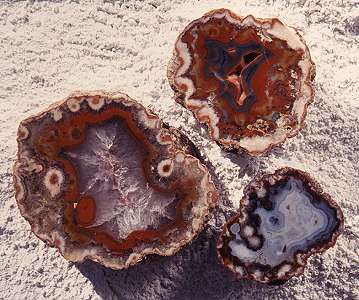|
We compared the sand found here to the sand we examined at our first stop at Road's End. The sand from this beach is better sorted, more uniform in grain size and roundness. The minerals present are very similar in content and quantity. I looked for agates here. Late winter is the best time to look since the sand has been removed by the winter surf leaving pebbles and cobbles to make up much of the foreshore. This photo is of agates that have been sliced and polished, and shows why they are such a lure. Agates along this coast are usually formed in vesicular basalt or massively crystalized in hydrothermal faults. These silicates are harder and more resistant to weathering than basalt and sandstone and remain long after the country rock has eroded. While scouting the beach I found the weathering surface of a very fine grained sandstone that showed the coloring of volcanic contact. Professor Hardesty determined this was probably the top of the Astoria Formation which was formed earlier than the Depoe Bay basalts. |

|
Created by STANLEY R. SANDERS, 1999
e-mail: sanders@transport.com
|
|
|
|